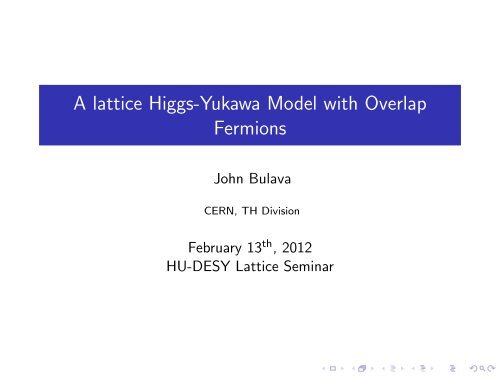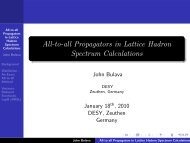A lattice Higgs-Yukawa Model with Overlap Fermions - Lattice Seminar
A lattice Higgs-Yukawa Model with Overlap Fermions - Lattice Seminar
A lattice Higgs-Yukawa Model with Overlap Fermions - Lattice Seminar
- No tags were found...
You also want an ePaper? Increase the reach of your titles
YUMPU automatically turns print PDFs into web optimized ePapers that Google loves.
A <strong>lattice</strong> <strong>Higgs</strong>-<strong>Yukawa</strong> <strong>Model</strong> <strong>with</strong> <strong>Overlap</strong><strong>Fermions</strong>John BulavaCERN, TH DivisionFebruary 13 th , 2012HU-DESY <strong>Lattice</strong> <strong>Seminar</strong>
OutlineMotivation/Introduction<strong>Higgs</strong> Boson Mass boundsFinite T phase transition
Collaborators:◮ DESY-Zeuthen, Germany: Karl Jansen, Attila Nagy, PhilippGerhold, Jim Kallarackal - <strong>Higgs</strong> mass bounds, Finite T phasetransition at large y◮ CERN: JB - <strong>Higgs</strong> mass bounds, Finite T phase transition atlarge y◮ National C.T. University, Taiwan: George Hou, David Lin,Bastian Knippschild, Brian Smigielski - bulk phase transitionat very large y
OutlineMotivation/Introduction<strong>Higgs</strong> Boson Mass boundsFinite T phase transition
Motivation◮ A heavy 4th gen. of quarksruled out.(t ′b ′ )has not been (completely)◮ Large m t ′ ,b ′ means large y t ′ ,b′. Perturbative methods may notwork.◮ <strong>Lattice</strong> field theory enables study of the <strong>Higgs</strong>-<strong>Yukawa</strong> sector(NO gauge fields) at large y.◮ Effects on the <strong>Higgs</strong> boson mass bounds from a possible 4Gare timely.◮ Effects on the thermal phase transition may be relevant forelectroweak baryogenisis.
The 4G is dead:◮ Direct searches: ATLAS, CMS most stringent bound∼ 450GeV in t ′ → bW, b ′ → tW.◮ <strong>Higgs</strong> boson production: Enhancement of σ H◮ Precision flavor observables: e.g sin2β s (LHCb). In 4Gsin2β s ∼ −0.33 (Hou, Ma ‘10)
The 4G is not dead:◮ Most stringent direct searches assume e.g.B(t ′ → bW) = 100%.◮ (Cetin, et al ‘11): Really should considerB(pp → H)×B(H → X)◮ (Lenz, et al ‘11): V CKM4×4 ≠ 1, l 4 really complicate things!Limits as a function of the mixing angles. (CKMFitter)SM3BR)10Fourth family neutrino <strong>with</strong> mass 45 GeV+ -(Dirac) (Majorana) gg→ H → W W , ZZ, ff(Dirac) (Majorana) gg→ H → γγ0.30-3×10p-value1.0/ σ×SM4(σ×BR)1BR(B → τν)0.250.200.150.100.90.80.70.60.50.40.3-110110 120 130 140 150 160 170 180 190 200<strong>Higgs</strong> boson mass [GeV]0.05CKM f i t t e rSummer 110.000.5 0.6 0.7 0.8 0.9 1.0sin 2β0.20.10.0
What can the 4G do for me? (Holdom et al, ‘08)◮ Alleviate tension btw. EW fits of M H and exclusion bounds◮ Dark matter candidate◮ More CKM phases → more CP violation◮ Enforces R-parity in MSSM (Wise, et al)◮ Possibilities of a UV fixed point (P.Q. Hung, et al)
Two questions we will ask:◮ How does the 4G affect <strong>Higgs</strong> boson mass bounds?◮ (Holdom, et al ‘08): Allowed range decreases <strong>with</strong> mf◮ Does this hold up non-perturbatively?◮ How does the 4G affect the EW-phase transition?◮ (Laine, et al ‘96): Gauge-<strong>Higgs</strong> models unsuitabe for EWbaryogenisis◮ Can large yukawas induce a 1st order transition?
Main Results<strong>Higgs</strong> mass lower bound:◮ Numerical data increasesw/ m q (blue points)◮ Trend suggested byminimizing the LO eff.100potential. (black line)200 400 600Thermalphasetransition(preliminary):m qT c0GeV 350GeV175GeV 500GeV650GeV 1000GeV1000900800700600low 500m H (GeV)400χ504540353025201510503002000.29Λ = 1.5TeV0.295(GeV) m t0.3κL=16fit to L=16L=20fit to L=20L=24fit to L=240.3050.31
IntroductionExamine the <strong>Higgs</strong>-<strong>Yukawa</strong> sector of the standard model:L = L φ +L FL φ = 1 ∑|∂ µ φ| 2 + 1 2 2 m2 0|φ| 2 +λ|φ| 4L F =µN f ∑i=1= ∑ i¯ψ i /∂ψ i +y b ¯ψ i L φbi R +y t ¯ψ i L˜φt i R +h.c.¯ψ i M[φ]ψ i◮ Complex scalar φ is a 2 of SU(2) L◮ Fermion doublet ψ = ( tb). ψL is a 2 of SU(2) L◮ NO GAUGE FIELDS!! ⇒ GLOBAL SU(2) L symmetry
Phase structure (e.g. Gerhold, Jansen ‘07): two order parameters(m,s).˜κN0.20.10-0.1-0.2-0.30SYMAFM24FMỹ NL = 8L = 66AFM810˜κN-0.45FMỹ NSYMAFML = 8LO Large-N f and N f = 10 MC results for fixed λ. Dashed (2ndorder) and solid (1st order) lines are phase transtions.We study the model in the (spontaenously broken)m = v ≠ 0,s = 0 FM phase.0.20.10-0.1-0.2-0.3◮ <strong>Fermions</strong> aquire a mass : m f ∼ yv◮ Spectrum: fermion, goldstones, and a massive scalar (<strong>Higgs</strong>)101520253035
UV fixed point is trivial: cutoff cannot be removed w/ non-zerointeractions.Triviality (upper) bound on m H (Daschen, Neuberger ‘83)(Luscher, Weisz ‘87):( Λln ≤m)A +Blng r +O(1)g rLarge-N f evidence that yukawa theory is also trivial (Kuti, et al‘07).Non-universal! Value of the bounds can vary by ∼ 20−30% <strong>with</strong>the <strong>lattice</strong> discretization. (Heller, et al. ‘93)No evidence for non-trivial f.p.’s at large coupling. (e.g. Weisz,Wolff ‘11).
Vacuum instability (lower) bound on m H (e.g. Elias-Miro, et al.‘11): Demand that Eff. potential ’curves up’.For φ 4 , bounds occur at λ = 0,∞.<strong>Higgs</strong> boson mass bounds [GeV ]700600500400300200100<strong>Higgs</strong> boson mass bounds [GeV]1000800600400200m t ′ = 676 ± 22 GeV05001000 1500 2000 2500Cutoff Λ [GeV ]3000015002000 2500 3000Cutoff Λ [GeV]3500(Gerhold, Kallarackal, Jansen ‘10)
History of <strong>Higgs</strong>-<strong>Yukawa</strong> models on the <strong>lattice</strong>◮ (Quenched) Naive fermions (Bock, et al. ‘89) : Doublers!!!◮ Wilson fermions (Smit ’86)(Swift ’84): Wilson term breakschiral symmetry.◮ Mirror fermions (e.g. Lin et al. ‘92): Tuning required todecouple mirror fermions.◮ <strong>Overlap</strong>! (Lusher ‘98): Exact chiral symmetry at finite a.
<strong>Lattice</strong> DiscretizationIntegrate out fermion fields〈0|O[ˆφ]|0〉 c =∫ ∏x dφ x O[φ] det M[φ] e −S[φ]∫ ∏x dφ x det M[φ] e −S[φ]Limit L s → ∞ must be taken. Finite T ⇔ Finite L t = 1 TContinuum Limit (a → 0) cannot be taken. Instead (providedam
Examine the free naive Fermion Propagator for m = 0D(p)∣ = −ia∑ µ γ µsin(ap µ )∑m=0 µ sin2 (ap µ )Poles at p µ = 0,π/a ⇒ 2d Fermion states!Theorem (Nielsen, Ninomiya ‘81): You CAN’T have all of thefollowing◮ Chiral Symmetry of the form{D,γ 5 } = 0 , D = ∑ µγ µ D µ◮ No fermion doublers◮ A real, local action.
NN thm workaround: Settle for the chiral symmetry (Ginsparg,Wilson ‘82) (Luscher, ‘98){D,γ 5 } = aDγ 5 DThe <strong>Overlap</strong> operator (Neuberger ‘97)[D (ov) = ρ 1+ √ A ], A = D W −ρA † AD W = γ µ ∇ µ − ar2 ∇2No gauge fields ⇒ D ovpp ′ = d(p)δ pp ′At finite a, action obeys a (modified) SU(2) Lφ → Uφ,U ∈ SU(2)ψ L = ˆP − ψ → Uψ L , ¯ψ L = ¯ψP + → ¯ψ L U †ˆP ± = 1± ˆγ 5 ( a, ˆγ 5 = γ 5 1−2 ρ Dov)
Introduce pseudo-fermion fields ω.(detM[φ]) Nf= e−ω † (M † M) −N f2 ωComputational cost dominated by M[φ]ωM[φ] = D ov +P + yΦˆP + +h.c.N f odd → PHMC (Frezzotti, et al)Simulation in momentum space: FFT algorithms are O(V logV)No expansion in D ov is needed!
Additional tricksFourier Accleration (Batrouni et al. ‘85) : longer MC time for lowp modesπ † π2 → ∑ pπ † π2m(p) , m(p) = 1 4 〈|F p[φ,ω]| 2 〉, τ p =τ√m(p)C(W)/2Γ(0)403530252015105No Four. accel.With Four. accel.Eff. traj. length boost 1/ √ m(p)1210864200102030405060Window size W708090002 4 6 8 10 12 14Squared <strong>lattice</strong> momentum ˆp 2(Gerhold ‘10)
Preconditioning : Assume SSB ansatzφ v = vˆφ, Q = M[φ v ] −1 , detM † M = detM † Q † QMCond. number of the product is not the produt of the cond. nums.!Condition number reduced by ∼ 100−1000100000cond(MM † )cond(MQQ † M † )cond(RNR 2 N † R)1000cond(MM † )cond(MQQ † M † )cond(RNR 2 N † R)Condition number100001000100Condition number10010100100 200 300 400 500 600 7000100 200 300 400 500 600 700(Gerhold, ‘10)Configuration index i MCConfiguration index i MC
Krylov reweighting: correct for finite expansion.Multiple-timescale Integration:◮ F p : Total force◮ F 1p : Psuedo-fermion◮ F 2p : ScalarForce strength1010.10.0100.5〈| ˜F p|〉〈| ˜F 1p|〉〈| ˜F 2p|〉1.5Squared <strong>lattice</strong> momentum ˆp 21Number of required appl. of MM †90807060504030201000Matrix appl. for W[Φ]Matrix appl. for W[Φ, ω]100200300400500Configuration index i MC600700(Gerhold, ‘10)
Set the scale using v phys = 246GeV. Λ = 1 a = vphysv RObtain the v.e.v from the rotated field (no ext. ‘trigger’ J)φ rot = 1 ( )0V | ∑ x( φ(x)| ) 0limV→∞ 〈φrot 〉 =vbare v is renormalizedv R = Z −1/2GvG = ∂∂pZ −12ReG−1G (p2 ) ∣∣p 2 =−m 2 G
−1 ˜G G (ˆp2 )Inverse propagator10.80.60.40.200κ = 0.123010.20.4Two Fit ansätze:0.60.8Squared <strong>lattice</strong> momentum ˆp 2◮ Perturbative. Fit:1Z G from fits to the G −1G (p2 ):L s /a = 32 = L t /am t = 175GeV, Λ = 1.2TeVZ G (Pert. Fit) : 0.9641(37)Z G (Linear Fit) : 0.9655(4)G −1G (p2 ) = 1Z G(p 2 +m 2 G +A[ I(p 2 ,m 2 H ,m2 G )−I(0,m2 H ,m2 G )])◮ Linear Fit:G −1G (p2 ) = p2 +m 2 GZ G
0.25TopBarTopCorrChiralLeftHandedGaugedχ 2 /dof = 0.780.17TopBarTopCorrChiralLeftHandedGauged¯ψt2 〉〈ψt10.20.150.10.05Effective masses meff(∆t)0.160.150.140.130.120.110.10.0900510152025303540450.080510152025∆t = t2 − t1∆t = t2 − t1Top quark mass determination: L s /a = 24, Λ = 1.5TeV,m t = 195GeV, λ = 0◮ Fits to temporal correlation function(Left):C(t) = Acosh [ m(t −L t /2) ]◮ Fit value and the effective mass (Right).m eff (t) = m+O(e −∆t )
Finite Volume EffectsFinite voume effects in O(4) symmetric EFT:◮ p-regime (m G >> 1/L) : F.V. effects are O(e −ML )◮ ǫ-regime (m G
OutlineMotivation/Introduction<strong>Higgs</strong> Boson Mass boundsFinite T phase transition
Experimental situation
Unstable states in F.V.If ‘alone’, F.V energy corresponds to I.V. pole up to (weak) F.V.effects.Near threshold, F.V energies are distorted. Avoided level crossingoccurs.Example: taken from (Gottlieb, Rummakianen ’95)◮ Two scalars: 4m φ > m ρ > 2m φ , L int = λ 14! ρ4 + λ 24! φ4 + g 2 ρφ2◮ Spectrum from GEVP <strong>with</strong> single and multi-particle ops.◮ Left: g = 0, Right: g = 0.008
Three ways to determine the higgs boson mass:Pole Mass:◮ Fits to the <strong>Higgs</strong> propagator◮ Describe the unstable nature perturbatively or ignore itCorrelator Mass:◮ fits to the temporal correlation function at large t◮ at very large t, dominated by two goldstonesResonance analysis:◮ (Rigorously) calculate δ(k) below inelastic threshold◮ Need to explictly break the symmetry to get m G ∼ m H /3◮ Much more difficult! However, can obtain Γ(H → GG)
1.21<strong>Higgs</strong>PropagatormaxP1.00Correlator from separate analysis of observable <strong>Higgs</strong>Correlator0.001χ 2 /dof = 0.02χ 2 /dof = 0.000.8Propagator0.60.4〈ht1ht2〉0.2000.20.40.60.810.0001051015202530354045ˆp 2∆t = t2 − t1Masses from the propagator and correlator:◮ Example: L s /a = 24 = L t /(2a), m t = 195GeV, Λ = 1.5TeV◮ Fits to the higgs propagator (left): m H = 96.0(4.3)GeV◮ Fits to the higgs temporal correlation function(right):m H = 96.4(6.9)GeV
δσδσδσ3c.o.m.m.f.1200λ = 0.012.5100021.51800600400δ(k) and σ(k)(Kallarackal ‘10):0.520000.0632.521.5c.o.m.m.f.0.080.1k0.120.140120010008006000.080.10.12 0.14kλ = 1.0◮ m t = 175GeV◮ L s /a ={12,16,18,20,24,32,40}10.500.0432.521.510.08c.o.m.m.f.0.12k0.160.20.2440020007006005004003002000.1 0.12 0.14 0.16 0.18 0.2 0.22 0.24kλ = ∞◮ Moving frame toincrease resolution(blue points)λ 0.0 1.0 ∞am res 0.278(2) 0.386(28) 0.405(4)am prop 0.2811(6) 0.374(4) 0.411(3)aΓ 0.007(1) 0.033(4) 0.040(4)0.5100000.04 0.08 0.12 0.160.20.2400.1 0.12 0.14 0.16 0.18 0.2 0.22 0.24kk
Perturbative CalculationsUse the same regulator: <strong>Lattice</strong> perturbation theory w/ D ovFinite volume: ∫ d 4 p → ∑ˆp µ, Large-N f limit.Constraint Effective Potential(Fukuda, Kryiakopoulos ‘75):VU(v) = [ S φ [v]−N f logdetM[v] ][ 1+O(N −1f) ]M H from curvature at the minimum.mH 2 = 8λv2 − 1 v U′ F (v)+U′′ F (v)U F (v) = −2N ∑flogVT ∣ ν+ (p)+y t v ( 1− ν+ (p)) ∣ 2∣∣ +2ρplog∣ ν+ (p)+y b v ( 1− ν+ (p)) ∣ 2∣∣2ρ
<strong>Higgs</strong> boson mass bounds [GeV ]700600500400300200100<strong>Higgs</strong> boson mass bounds [GeV]1000800600400200m t ′ = 676 ± 22 GeV0500100015002000Cutoff Λ [GeV ]2500300001500200025003000Cutoff Λ [GeV]Dependence of mass bounds on cutoff (Gerhold, Kallarackal,Jansen ‘10):◮ Lower bound has weak cutoff dep.◮ Splitting seems to be a small effect at m t = 175GeV◮ Lower bound increases w/ m t .3500
1000800700upper boundlower bound (preliminary)lowm H (GeV)900800700600500400300Λ = 1.5TeVM P H [GeV]600500400300200200100200 400 600m t (GeV)1000100 200 300 400 500 600 700 800mt ′ [GeV]Dependence of the <strong>Higgs</strong> Mass bounds on m q at Λ = 1.5TeV (JB,Kallarackal, Jansen, Nagy, in prep):◮ TODO: Include corrections to Z G◮ (Denner, et al. ‘11): For m t ′ ∼ 600GeV, EW rad. corrs. inH → WW,ZZ are −60%.◮ ‘Window’ narrors w/ m t .
OutlineMotivation/Introduction<strong>Higgs</strong> Boson Mass boundsFinite T phase transition
Electroweak baryongenisisWe live in a matter dominated universe!Sakharov Requirements for generated a matter/antimatterasymmetry◮ Baryon number violation◮ CP violation (and C violation)◮ Out-of-equilibrim dynamicsStandard <strong>Model</strong> (in principle) can generate all of these.
First order phase transitions require bosonic degrees of freedom.scalar vev. is no longer order param. (Fradkin, Shenker ‘76)In gauge-higgs models, line of 1st order, tricritical point (Laine, etal ‘96)Critical point occurs at an m H below LEP bound!yupper metastability linecritical linecritical pointlower metastability linex c0xinfinity
Finite T transition(Kikukawa, et al. ‘09): 4th generation may cause strongly 1storder EW phase trans.L 3 s ×L t <strong>lattice</strong> ⇔ grand-canonical ensemble w/ T = 1 L t.In pure φ 4 phase transition is second order (e.g. Jansen, Seuferling‘90)With scalars and SU(2) gauge fields, transition is first order (e.g.Fodor, et al. ‘95)Strategy:◮ Fix L t /a small◮ Vary κ at fixed λ and y. Find κ c .◮ Do an L t ≈ ∞ simulation using κ c ,λ,y.◮ Set the scale in the usual way. Use a to determine L t fromL t /a.
Susceptibility Fits(JB, Jansen, Nagy, in prep.):χ = A ( L −2/νs +B(κ−κ c ) 2) −γ/2 , ν = 0.68, γ = 1.38Left: L t /a = 4, Right: L t /a = 6 (at m t = 175GeV).40353025L=16fit to L=16L=20fit to L=20L=24fit to L=245045403530L=16fit to L=16L=20fit to L=20L=24fit to L=24χ20χ2515105201510500.290.2950.3κ0.3050.3100.290.2950.3κ0.3050.31L t /a T c (GeV) m t (GeV)4 517.5(2.8) 1756 509(11) 1754 1000 650compare to T c = 350GeV in the pure φ 4 .
ConclusionsEffects of a Heavy Fermion doublet can be studied for arbitrary yusing <strong>lattice</strong> techniques.◮ <strong>Higgs</strong> Boson mass bounds◮ <strong>Higgs</strong> Boson Resonance parameters (w/ m G ∼ m H /3)◮ Finite Temp. phase transitionThe <strong>Higgs</strong> mass lower bound seems to depend strongly on m q ,similiar to LO eff. potential.Finite T phase transition studies are underwayFuture Plans:◮ Examine the effects of adding D > 4 terms to the action.◮ Complete Finite Temp. study◮ Bound states?◮ Examine the effect of gauge fields.




